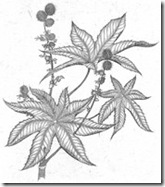Read to the end of the article to find out how you can win an autographed copy of Wicked Plants!
 Y’all know by now what a huge fan I am of Amy Stewart and her writing. As a plant geek, I love how accurate she is about the plants’ details (so many writers get basic plant info just plain wrong), and the way she brings the human and plant worlds together makes her books good reading even for people who don’t have a particular interest in plants.
Y’all know by now what a huge fan I am of Amy Stewart and her writing. As a plant geek, I love how accurate she is about the plants’ details (so many writers get basic plant info just plain wrong), and the way she brings the human and plant worlds together makes her books good reading even for people who don’t have a particular interest in plants.
Amy talks about how she chose which botanical lowlifes to profile in her latest book, Wicked Plants:
I looked for plants that had an interesting backstory. There had to be a victim–a body count. If a plant killed someone famous, like Socrates or the mother of Abraham Lincoln, I included it. If it was involved in a notorious murder case, like that of serial killer Dr. Thomas Neill Cream, or if it had attacked a person in a particularly gruesome way, it made the cut.
 One of my favorite stories involves a plant I love but can’t have – the Castor Bean (etching at left is from the book!). While the seeds are poisonous enough that three or four of them can kill you (eeek! Not in my garden…), there is an innocuous oil made from the seeds that is a useful laxative. In all the old-fashioned stories, naughty children who eat too much candy are treated to a dose of castor oil, and they run in horror from Mother and her measuring spoon of oil.
One of my favorite stories involves a plant I love but can’t have – the Castor Bean (etching at left is from the book!). While the seeds are poisonous enough that three or four of them can kill you (eeek! Not in my garden…), there is an innocuous oil made from the seeds that is a useful laxative. In all the old-fashioned stories, naughty children who eat too much candy are treated to a dose of castor oil, and they run in horror from Mother and her measuring spoon of oil.
What I didn’t know is that in the 1920’s, Mussolini’s guys acted out similar scenes with their dissidents – chasing them down and pouring castor oil down their throats to inflict them with a nasty case of diarrhea. Amy quotes Sherwood Anderson as saying:
It was amusing to see Fascisti, wearing black shirts and looking very earnest, bottles sticking out of their hip pockets, chasing wildly down the street after a shrieking Communist. Then the capture, the terrible assault, hurling the luckless Red to the sidewalk, injecting the bottle into his mouth to the muffled accompaniment of blasphemy of all the gods and devils in the universe.
Deliciously wicked, no?
I’ve been reading Wicked Plants all week before bed, and while I’m happy to report there have been no nightmares, unfortunately my loud snickers have gotten the book banned from the bedroom, at least when the Mr is trying to sleep. Sorry, sweetie!
If you’re a fan of Amy’s as well, or just have a taste for the weird and wicked, check out this local talk Amy did about the stars of her new book. I love her energy, and if she’s coming to your town during her book tour, you don’t want to miss her!
Want to win an autographed copy of Wicked Plants?
 I bought one fresh off the press at Amy’s local book launch party and had her sign it for one lucky reader. For your chance to win, simply tell me about your favorite wicked plant (define that any way you like – poisonous, goth, invasive, annoying – whatever!) by leaving a comment below.
I bought one fresh off the press at Amy’s local book launch party and had her sign it for one lucky reader. For your chance to win, simply tell me about your favorite wicked plant (define that any way you like – poisonous, goth, invasive, annoying – whatever!) by leaving a comment below.
On May 20th, I’ll choose one lucky reader at random. You must either live in the US or have a US shipping address to be eligible to win. Good luck!
Check out Amy’s movie trailor for Wicked Plants here.
11 responses to “Amy Stewart’s Wicked Plants Book has Arrived! (with Video and a Contest!)”
Thanks for posting Amy’s video.
It’s interesting how time changes one’s awareness of ‘DANGEROUS’. I had bowls of Castor seeds, they were so beautifully patterned and shiny.
On a garden level I’d pick ivy. It’s everywhere. It can be dwarf or needle point, but eventually it will metastasize into plain ivy engulfing buildings and a horrid allergen. Sneeze.
On the environmental level, up here in Oregon, it’s got to be Scots broom. It’s spread everywhere. It’s the first plant I understood as a transPLANT out of control and has helped shaped my awareness and responsibility as a gardener.
Very interesting stuff! Some great stories in there. Love the seaweed on steroids!
As for my favorite wicked plant? That’s gotta be the Manchineel Tree, aka the beach apple or death apple. While the fruit is apparently really bad news (although I always wondered WHO these people were who picked up random fruit off the ground and just started eating it), what I love about this tree is that you can’t even stand under it when it rains. Those who make the mistake of doing so (which I think is rare now that in most places where this beauty grows they are marked with a skull and crossbones or something along those lines) will be treated to a severe case of blisters. It’s tricky too, because they seem to form a really nice canopy: just the kind of place you want to take shelter during a torrential downpour. Want to get rid of it? Well good luck with that. If you cut down this member of the spurge family and then try to burn it, the smoke can blind you. Oh yeah, this one’s a real lover. Sort of the black widow of trees: woo ’em in, and strike ’em hard.
Erin’s last blog post..At the feeders
I hate to disappoint you, but the castor bean plant isn’t as dangerous as I hoped in my garden. It had no effect whatsoever on either the annoying groundhog or the annoying unneutered male cat from a few doors down! Maybe I should grow the kind you have (or don’t have. Um, never mind).
Monica the Garden Faerie’s last blog post..Mish-Mash Monday
Hooray for Amy!
Humboldt is a great gardening county, housing both Amy and Gen.
Wicked plants? I’m going for the Goth/Morticia Addams category and my pick is Tulipa ‘Queen of the Night’. Black tulips, black swans–beautiful but eerie.
Daffodil Planter’s last blog post..Mute Monday
The bedtime book ban made me chuckle. I just have the dogs to give me reproachful looks as I interrupt their slumber.
My favorite and least-favorite “wicked” plant locally is the Star of Bethlehem. It’s a very, very pretty spring/early summer bulb that can grow from the ground to flowering almost overnight. I’ve also seen it called False Garlic locally, but I think that’s a different species. Without knowing that it’s poisonous, many property owners allow it to propagate in their lawns because it’s just flat-out pretty, with little clusters of white flowers waving in the breeze a few inches above the greening grass as it’s awaking from it’s winter slumber.
It’s poisonous even in small amounts to children and dogs, and it grows in with the sweet bermudagrass that my dogs like to crop in the backyard.
Karl Katzke’s last blog post..Pulling the Kohlrabi
Hi! You have a great blog. My husband and I lived just a wee bit north of Fortuna for about 3 years right after our marriage. Northern California is actually where my love of gardening blossomed. I went through the ag progam at CR. We love the area and get homesick for it sometimes. Now I am gardening with my four little boys (and my husband too!) in the beautiful Shenandoah Valley of Virginia. My pick for a wicked plant is the vile alianthus altissima, or tree of heaven. It is awful!!!!! And unfortunately on my property : (
I love the idea of wicked plants. I can’t think of any particular experiences I have had, so instead I’ll share my wish list of wicked plants I’d like to own.
A shrub that releases a mild sedative into the air at 10:30 or so in the evening, making my dinner guests drowsy and encouraging them to go home already.
A mutant strain of hosta that eats snails instead of being eaten by them.
A winter vegetable that uses captive mycorrhizae to spread its essence to any squash, eggplant or brussel sprouts growing nearby, thereby making them taste like chocolate. (Can you tell what my least favorite vegetables are?)
Any chance one of these is mentioned in Amy’s book?
Susan (garden-chick)’s last blog post..Celebrating Mother’s Day in the Garden (hers to be exact)
I’ve loved all of Amy’s books and can’t wait to read Wicked plants! And I do have a story about Euphorbia characias wulfenii * Mediterranean Spurge. In my garden, this plant was thriving, 5 feet at least, and reseeding like crazy. When it needed a haircut so the seed pods wouldn’t get everywhere, I carefully donned long sleaves and gloves because the sap can do a number on your skin. And I’m wearing glasses, so no worries there.
Except I bent down to cut one low to the ground after I’d cut some higher up, so some sap dripped on my eyebrow. After I was done, I had a nice shower and noticed some stinging in my eye. I tried to rinse out the eye, but the stinging got worse. At the emergency room, the doctor said “Euphorbia? Thanks for bringing some, I’ve always wanted to see it. It happens often.”. Then the poured a few gallons of water over the eye and did a thorough examination. Fortunately, I had come soon enough and no permanent scarring of the eye had resulted.
I had those wicked plants taken out professionally the next spring, and insisted on everyone wearing safety glasses.
Town Mouse’s last blog post..Real Gardeners…
Hi Genevieve, you make a great saleswoman for this book. I do have a black themed garden with dark foliage, flowers or dark red or orange flowers. Dangerous? Probably not. Digitalis though is a favorite here however. 🙂
Frances
Frances’s last blog post..Iris Season
Hmmm… so many great wicked plants.
But my wickedest is the Cordyceps genus of fungi. They infect insects and control thier behavior in order to increase reproductive success. An epic video presentation is found here:
http://www.youtube.com/watch?v=vgkL8PulPdE
Another great write up can be found in Paul Stamets “Mycelium Running” which details the hi-jacking of an ant. Spores first land upon the ant and grow into the ant’s body infecting the brain. It then commands the ant to climb to the tallest available point. After reaching an appropriate height for sporulating, the ant then bites down, lockjaw-style, securing a proper spot to die. Then the mushroom grows from the ant maximizing the dispersal of it’s spores.
My runner up is Darlingtonia Californica. Standing tall in serpantine bogs like mountain royalty, the cobra lily is the perfect blend of beauty, function, and specialization. http://www.coloradocarnivorousplantsociety.com/darlingtonia_californica1.htm
By my comment, in case it wasn’t clear, castor bean is my favorite wicked plant! 🙂